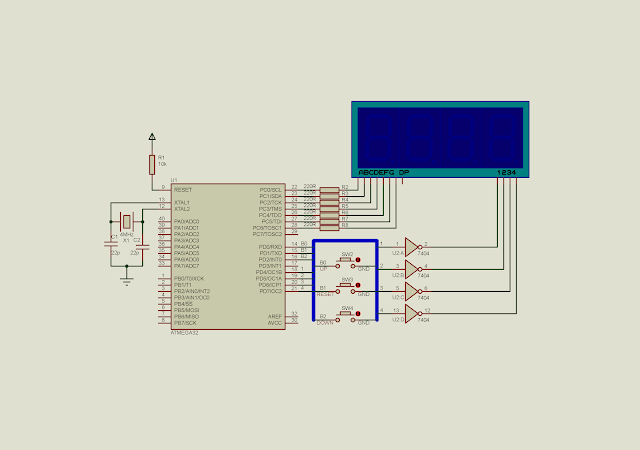The program process is describing as follow:
- A four-digit multiplexed SSD display activated by timer 0 interrupt. Each digit is activated within 5 milli seconds period. The period created by timer 0 ISR.
- Three keys, up counter , reset counter and down counter are activated for every 200 milli seconds. Again this 150 milli seconds period generated by timer 0 ISR.
I do not describe the core programming of timer 0 here since I have done it in the previous post.
The C source codes is here.
#include <avr/io.h>
#include "avr/interrupt.h"
#define upButton ((PIND&0x01)==0)
#define resetButton ((PIND&0x02)==0)
#define downButton ((PIND&0x04)==0)
/*System clock ticks for SSDs*/
unsigned char ssdTick=0,digit=0;
/*System clock ticks for keys*/
unsigned int found1=0,found2=0,found3=0;
unsigned int pressedCounter=1234;
void display(void){
unsigned char patterns[16]={0x3F,0x06,0x5B,0x4F,0x66,0x6D,0x7D,
0x07,0x7F,0x6F,0x77,0x7C,0x39,0x5E,0x79,0x71};
switch(digit){
case 1:
PORTD=0x07;
PORTC=patterns[pressedCounter/1000];
PORTD=0x17;
break;
case 2:
PORTD=0x07;
PORTC=patterns[(pressedCounter%1000)/100];
PORTD=0x27;
break;
case 3:
PORTD=0x07;
PORTC=patterns[(pressedCounter%100)/10];
PORTD=0x47;
break;
case 4:
PORTD=0x07;
PORTC=patterns[pressedCounter%10];
PORTD=0x87;
break;
case 5:
digit=0;
break;
}
}
void buttonScan(){
if (found1>=200)
{
if(upButton)
if(pressedCounter<10000)
pressedCounter+=1;
found1=0;
}
if (found2>=200)
{
if(resetButton)
pressedCounter=0;
found2=0;
}
if (found3>=200)
{
if(downButton)
if(pressedCounter>0)
pressedCounter-=1;
found3=0;
}
}
int main(void)
{
//Set PortC to Output
DDRC=0xFF;
//Clear PortC
PORTC=0x00;
DDRD=0xF8;
PORTD=0x07;
PORTC=0x00;
//Set 1:256 prescaler
TCCR0=0x04;
//Clear overflow flag
TIFR=0x01;
//Enable Timer 0 interrupt
TIMSK=0x01;
//set global interrupt
sei();
while (1)
{
display();
buttonScan();
}
}
ISR(TIMER0_OVF_vect){
//Load -16 to make 1 mS interrupt time
TCNT0=-16;
ssdTick+=1;
//increase counters for SSD
if(ssdTick>=5){
digit+=1;
ssdTick=0;
}
found3+=1;
found2+=1;
found1+=1;
//Clear Flag
TIFR=0x01;
}
Back to main tutorial page ATMega32 tutorials in C with Atmel Studio 7.

No comments:
Post a Comment